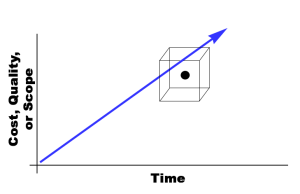
A few years ago I was part of a project which involved replacing a bridge over an irrigation canal. Because the canal authority shut off the water when winter set in and turned it back on in the spring, winter was a perfect time to build this bridge. We wrote penalties into the construction contract if the contractor held up the irrigation authority’s ability to turn the water in the canal back on.
Unfortunately there were some things that happened related to construction (design changes, etc.) which caused the bridge to be delayed. Once the date for opening of the canal was nearing, the irrigation authority told us that the penalties we put in the contract weren’t remotely close to the economic damages suffered by the downstream users of the water. They were considering legal action if they couldn’t turn on the water by their preferred date.
Although the agency that owned the bridge was quite happy with the work the contractor was doing, one of the “stakeholders” was not happy.
Was the project a success, then?
Most people would say that it was not. Clearly then, the definition of “project success” includes more than satisfying the project initiator (the “project sponsor” in project management lingo).
The Definition of a Successful Project
In project management, everything is built upon a foundation called critical success factors. These are the criteria that a project needs to satisfy. They are the definition of project success.
Very few projects are completed within the original planned constraints of time, cost, and quality. There are almost always changes that occur which also impact the success criteria, especially for innovative projects. Therefore, project success could theoretically occur even without hitting the exact target as originally planned. In that sense, the target is not a point, but a cube.
Primary Critical Success Factors
Primary critical success factors are those that are central to the project definition, like building a bridge that doesn’t fail under traffic loading, or building a fence that keeps the dog inside. Also, things like finishing on time or staying below the budget are also considered primary, if the “project sponsor” considers that as part of project success.
They are usually seen through the eyes of the project sponsor, or customer, who initiated the project or is paying for it.
Secondary Critical Success Factors
Secondary success factors are the ones that originate from so called passive stakeholders – like irrigation authorities. In the case of building your fence, how about avoiding a gas line with the fence posts, or utilities in general.
Almost every project has other parties who are impacted by the work. Defining what those project requirements are results in secondary critical success factors. Each of the following stakeholders can have their own definition of project success, such as:
- Consumers: Safety in product use
- Employees: Job security
- Management: Financial health
- Investors: Profitability
- Regulatory Agencies: Compliance with regulations
Luckily the contractor building our bridge got out of the canal with only a few days delay to the canal and everything ended normally. But suffice it to say that one of the critical success factors was to keep the irrigation canal authority informed and satisfied.
Role of Communication in Project Success/Failure
I’ve always been somewhat amused at the way that in my industry a project manager ends up in the doghouse even though a project gets delivered on time, on budget, and nothing goes catastrophically sideways. I seem to regularly ask myself “what did they ever do so wrong?”
The most important thing is not even so much to get the project perfectly right, but to communicate with stakeholders. If they feel consulted they will allow for some project changes without being disappointed. But if they are not consulted they will not have a high opinion of the project regardless of how good it goes. Project failure falls into two camps:
- Planned failure is that which is a result of poor planning. A budget or schedule that was unrealistic, or a project scope that wasn’t well defined.
- Actual failure is when the project goals were well planned but were not achieved within acceptable boundaries. If the stakeholders consider the project to be outside of the cube we discussed before, it has not been a success.
The sum of planned and actual failure is called perceived failure. If your project is perceived to be a failure, you have not been successful as a project manager, even if the project achieved all it’s other goals.
The opposite is also true. I would usually (but not always) consider the project a success if the stakeholders are satisfied but the project didn’t achieve it’s intended goals. For example, in our fence building project example, if you ended up building a trench filled with water instead of a fence but it keeps the dog inside and makes the neighbor happy, hey, it’s a success right? I would argue the project plans should have been changed to define the new scope, therefore it’s actually the “new” project that is a success, not the old one. But suffice it to say that communication is integral to project success.
Checklist
Usually there is a list of five or more things that most projects need to satisfy in order to be considered a success. Here is a list of questions to aid in brainstorming:
- Was the project completed on time?
- Did it stay within budget?
- Are the stakeholders satisfied?
- Did it or can it result in follow-up work?
- Did it meet the proper performance or specification level?
- Is the result acceptable to end user/owner?
- Were the scope changes minimal and/or agreed upon?
- Did it avoid unnecessary disturbance to the main work flow of the organization?
- Did it avoid changing the corporate culture?
- Did it advance the corporate goals of the organization?
- Did it meet ethical, moral, or safety standards?
- Were the applicable regulations followed?
Examples
Here are some examples of good critical success factors:
- Construct a dam that contains a 1:100 year storm event, does not fail under the full water loading at a safety factor of 2.5, and satisfies all the other design specifications of <X>.
- Complete the project and hold a final inspection with the client before <Date>.
- Ensure that adjacent landowners are satisfied with the partial loss of their ocean views, and loss of privacy.
- Avoid unnecessary disturbance to the river, including the deposition of silt material, garbage from construction, and relocation of the bed and banks.
- Achieve a profit of <X>.
- Position the corporation for follow up work. This will be achieved via strong communication and regular updates to client <X>, and prompt responses to design questions.
Today’s Task
Today’s exercise is to determine the critical success factors for the project you chose in the introductory post. Write them out in point form.
- Consider the primary stakeholders, like your customer/client/project sponsor.
- Consider the secondary stakeholders, like the regulatory agencies and other passive stakeholders who are impacted by the work.
- Consider stakeholders who have an active, but opposing interest. In the fence example, neighbors must be satisfied, and the city must issue a permit. I don’t mean to imply they are your enemies; I simply use the term to aid in brainstorming.
- Itemize anything that will make your project a success.
At this point, you have defined your project and its success or failure. I hope you’re seeing the benefit and starting to feel like it’s going to reap some rewards. But there’s lots more to go! This is just the beginning, so let’s move on to project stakeholders.
Navigation







